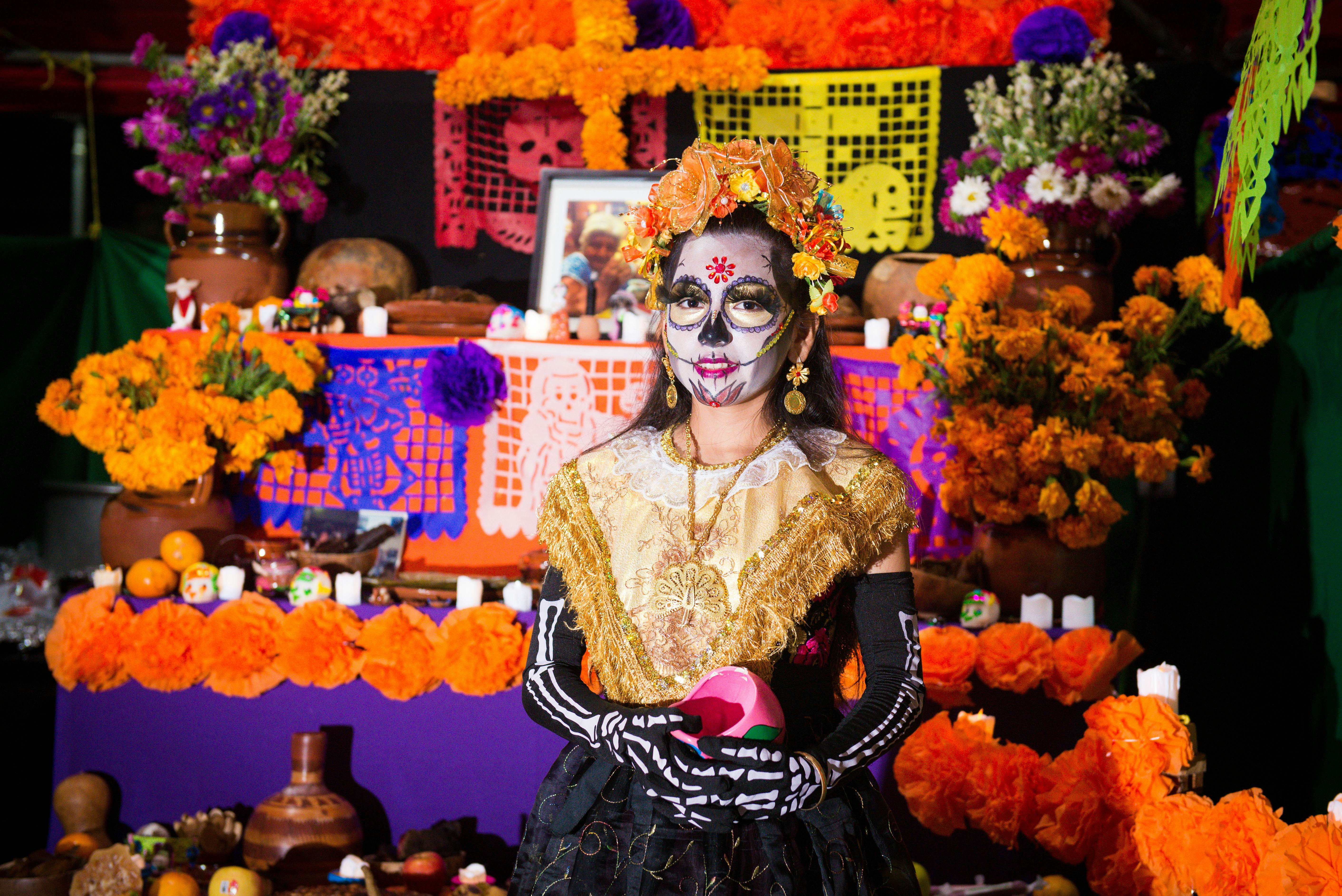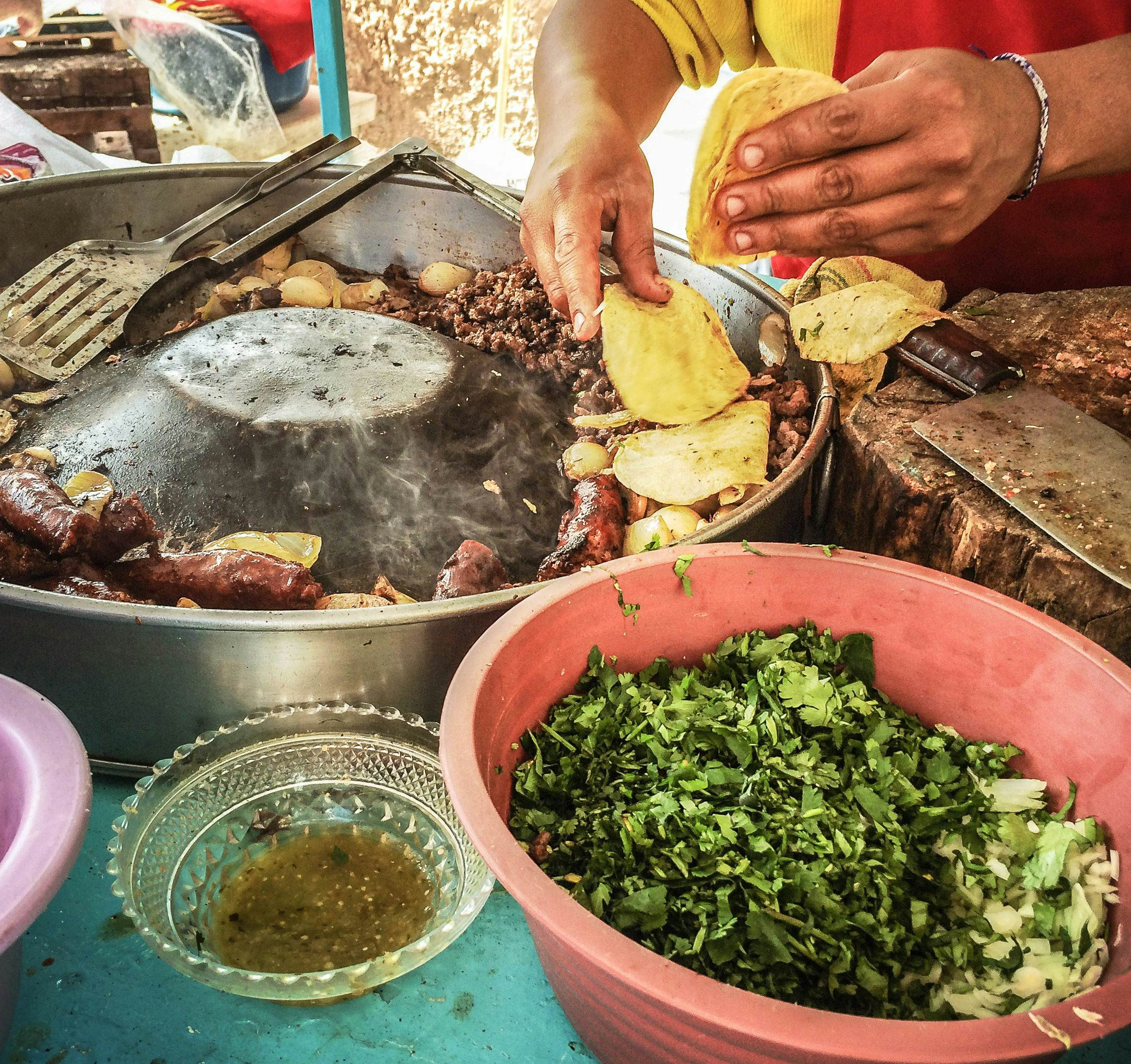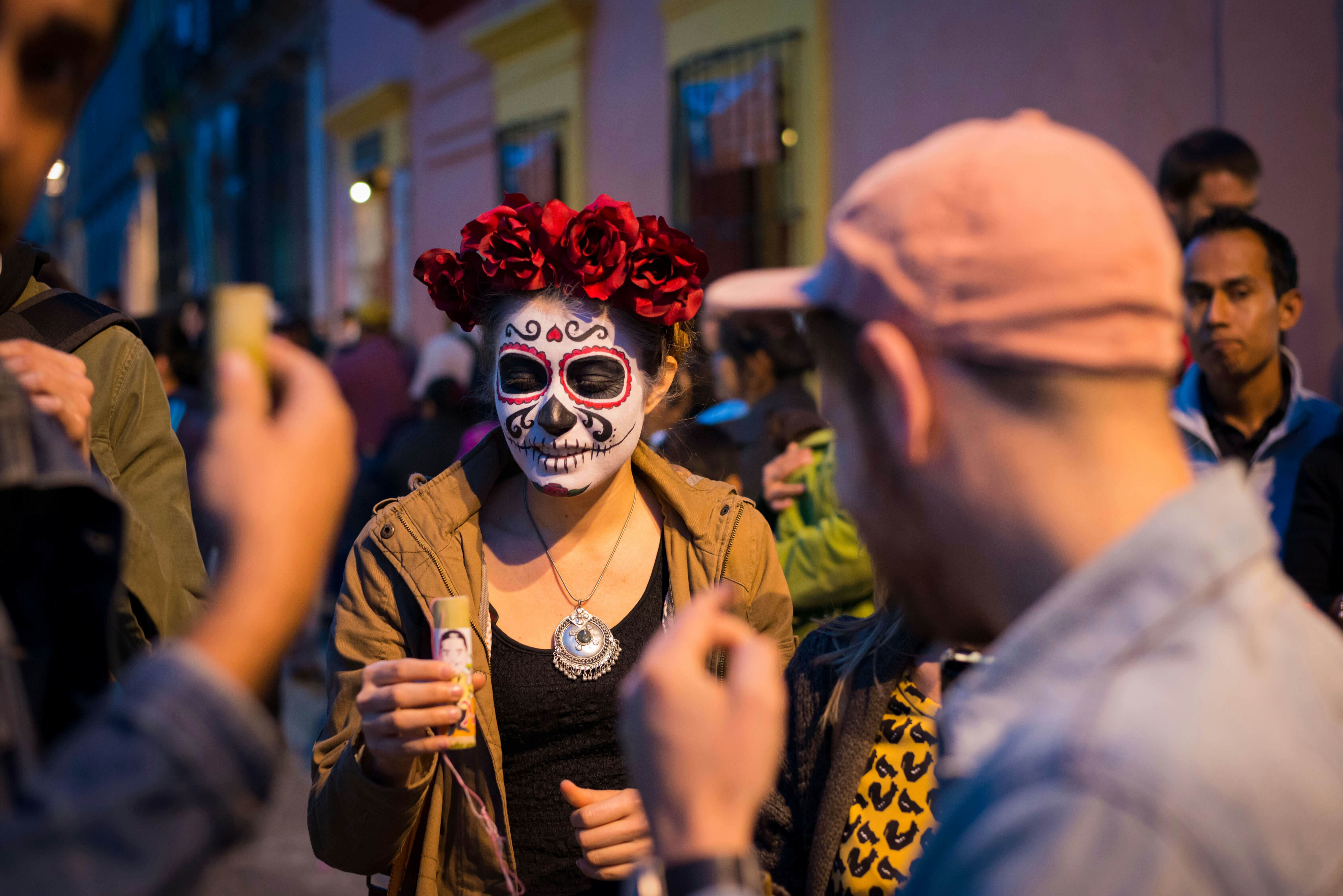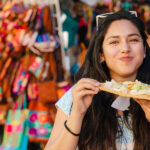How Is The Day Of The Dead Celebrated In Mexico? The Day of the Dead in Mexico, or Día de Muertos, is a vibrant and heartfelt celebration where Mexicans honor and remember deceased loved ones, weaving together mourning and joy. At gaymexico.net, we provide insights into this unique cultural phenomenon, especially for LGBTQ+ travelers and enthusiasts seeking to experience Mexico’s rich traditions. Explore the intersection of Mexican culture and LGBTQ+ acceptance with us, your go-to resource for inclusive travel, queer cultural events, and community stories, ensuring an unforgettable and respectful experience of Día de Muertos.
1. What is Día de Muertos (Day of the Dead)?
Día de Muertos, or Day of the Dead, is a deeply significant Mexican holiday that honors deceased loved ones. It’s a time when families come together to remember and celebrate the lives of those who have passed away. According to UNESCO, Día de Muertos is recognized as a unique celebration of death and a core part of the Mexican experience, emphasizing its cultural importance.
1.1. The History of Día de Muertos
Día de Muertos dates back over a thousand years to the indigenous peoples of central Mexico, including the Toltecs and Aztecs. They believed that the spirits of the dead return to their communities once a year. With the arrival of Spanish colonizers, the celebration evolved, incorporating Catholic traditions and rituals. This blend of indigenous and Catholic influences has created the unique and vibrant celebration we know today.
1.2. The Significance of Día de Muertos
Día de Muertos is more than just a remembrance of the dead. It is a celebration of life, both past and present. It is a time for families to reconnect with their ancestors and share stories, food, and memories. The holiday emphasizes the cyclical nature of life and death, highlighting the belief that death is a natural part of the human experience. It’s also a time when LGBTQ+ individuals can find community and cultural connection, celebrating their heritage and honoring those who came before.
1.3. How Does Día de Muertos Reflect Mexican Culture?
Día de Muertos is a quintessential Mexican celebration filled with family, food, and music, where all are welcome and none are forgotten. It reflects Mexico’s unique perspective on death as a natural part of life, blending mourning and remembrance with joy. The holiday also highlights the importance of family and community in Mexican culture, as families come together to honor their ancestors.
2. When is Día de Muertos Celebrated?
Día de Muertos is celebrated on November 1st and 2nd. However, preparations and regional celebrations often begin in mid to late October.
2.1. Día de los Inocentes (Day of the Innocent Ones)
November 1st is dedicated to children who have passed away and is known as Día de los Inocentes or Día de los Angelitos. This day focuses on remembering and honoring the lives of young ones, with families often creating special altars and offerings tailored to children.
2.2. Día de los Muertos (Day of the Dead)
November 2nd is centered around adults who have passed away and is called either Día de los Muertos or Día de los Difuntos. This day is marked by more elaborate celebrations, including visits to cemeteries, family gatherings, and the sharing of food and stories.
2.3. The Evolution of the Dates
Originally celebrated in August during pre-Columbian times, Día de Muertos evolved to coincide with the Catholic holidays of All Saints’ Day and All Souls’ Day. This alignment with Catholic traditions reflects the blending of indigenous and European influences in Mexican culture.
3. Setting Up an Ofrenda (Altar)
One of the most important traditions of Día de Muertos is setting up an ofrenda (altar) to honor the deceased. These altars are a focal point of the celebration, serving as a place for families to remember and connect with their loved ones.
3.1. The Purpose of an Ofrenda
The ofrenda is a representation of a family’s remembrance of someone they loved. For many, it represents a homecoming, a place for their family’s spirits to return to during this time of year. It’s a heartfelt tribute that combines personal memories with traditional symbols.
3.2. Common Items Displayed on an Ofrenda
Ofrendas can be simple displays or elaborate multi-level affairs, but all share the same elements:
- Photos of the deceased: These serve as a visual reminder of the loved ones being honored.
- Food and drink they enjoyed in life: These offerings cater to the tastes and preferences of the deceased, providing a symbolic feast for their spirits.
- Small items they loved: These can include toys, bottles of nail polish, books, or any other personal items that held significance for the deceased.
- Candles: These light the way for the spirits to find their way home.
- Flowers: Marigolds are particularly popular, as their bright color and strong scent are believed to attract spirits.
- Crucifixes and images of saints: These reflect the Catholic influences on the holiday.
- Papel picado: Colorful, perforated paper banners that add a festive touch to the ofrenda.
 A beautifully decorated ofrenda for the Day of the Dead, adorned with photos, candles, and marigolds.
A beautifully decorated ofrenda for the Day of the Dead, adorned with photos, candles, and marigolds.
3.3. How to Personalize an Ofrenda
Personalizing an ofrenda is crucial to making it a meaningful tribute. Include items that reflect the unique personality and interests of the deceased. For LGBTQ+ individuals, this might include symbols of pride, photos from significant events, or mementos from their favorite queer artists or icons.
4. Visiting the Cemetery
Visiting the cemetery is another central tradition of Día de Muertos. Families gather at the graves of their loved ones to clean, decorate, and spend time in remembrance.
4.1. The Atmosphere of the Cemetery During Día de Muertos
The energy in the cemetery is often both festive and respectful. Families bring folding chairs and blankets to settle in for a day, and even a night, of food, drinks, and storytelling. Live music is common, with musicians winding their way through the cemeteries, stopping at gravesite after gravesite to play the favorite tunes of the deceased.
4.2. Decorating Graves with Flowers and Candles
Regardless of regional differences, Día de Muertos is a time when Mexicans go to their cemeteries to clean the graves of their loved ones and decorate them with flowers and candles. This act of care and remembrance is a tangible way to honor those who have passed away.
4.3. Sharing Food, Drinks, and Stories at the Gravesite
Sharing food, drinks, and stories at the gravesite is a way to keep the memory of the deceased alive. Families share their favorite memories and anecdotes, laughter and tears mingling in a celebration of life. For LGBTQ+ individuals, this can be a time to share stories of resilience, love, and community.
 Gravesites illuminated by candlelight during Day of the Dead celebrations in San Andres.
Gravesites illuminated by candlelight during Day of the Dead celebrations in San Andres.
5. The Significance of Marigolds
Flowers play a crucial role in Día de Muertos celebrations, and the bright orange cempasúchil (marigold) is considered the official flower of the dead in Mexico.
5.1. The Symbolism of Cempasúchil (Marigolds)
Native to the central part of the country, marigolds have been used in Day of the Dead celebrations since ancient times. People believed that its vivid hue and musky fragrance helped lead spirits back to their homes.
5.2. How Marigolds are Used in Día de Muertos
Today, marigolds remain popular for ofrendas and gravesites, especially in the central and southern parts of Mexico. Cemeteries transform into seas of orange, and marigold petals are strewn before altars in a nod to ancient beliefs. The vibrant color and strong scent of marigolds symbolize the beauty and fragility of life.
5.3. Other Flowers Used in Día de Muertos
While marigolds are the most iconic flower of Día de Muertos, other flowers are also used to decorate ofrendas and gravesites. These include:
- Chrysanthemums: These flowers symbolize mourning and remembrance.
- Baby’s breath: These delicate flowers represent purity and innocence.
- Gladiolus: These tall, elegant flowers symbolize strength and remembrance.
6. Preparing Traditional Food
Food is an integral part of Día de Muertos. Ofrendas will feature the favorite foods of the deceased, representing not just their preferences but also different regional cuisines.
6.1. Regional Dishes Featured in Día de Muertos
Ofrendas often showcase regional dishes that reflect the culinary diversity of Mexico. Some popular examples include:
- Mole negro in Oaxaca: A slow-cooked sauce made with hoja santa chili, chocolate, onions, and garlic, often served with chicken.
- Pozole in Mexico City: A traditional Mexican stew with meat, shredded cabbage, chili peppers, onion, garlic, radishes, avocado, salsa, and lime.
- Calabaza en tacha in Yucatán: Candied pumpkin cooked in sugar cane syrup.
6.2. Pan de Muerto (Bread of the Dead)
One food that’s almost universally present, however, is pan de muerto (bread of the dead). This spongy, egg-based bread sprinkled with sugar comes in a round loaf with bone-shaped decorations – a representation of the cycle of life and death.
6.3. Other Common Foods and Drinks
In addition to pan de muerto, other common foods and drinks found on ofrendas include:
- Tamales: Steamed corn dough pockets filled with meat, cheese, or vegetables.
- Fruits: Fresh fruits such as oranges, apples, and bananas are often included.
- Candies: Colorful candies and sweets are offered, especially for children.
- Atole: A hot, corn-based drink.
- Hot chocolate: A comforting and traditional beverage.
- Coffee: A staple drink enjoyed throughout Mexico.
 A vendor in Mexico City preparing traditional foods for Day of the Dead celebrations.
A vendor in Mexico City preparing traditional foods for Day of the Dead celebrations.
7. Skeleton Imagery and La Catrina
Skeleton imagery has become increasingly common in Día de Muertos celebrations, largely due to the popularity of La Catrina, a high-society skeleton sporting a feather boa and an oversized Victorian-era hat.
7.1. The Origin of La Catrina
Created in the early 1900s by the satirical cartoonist José Guadalupe Posada, La Catrina embodies the reality that death spares no one, rich or poor. The image was later adopted into the national psyche through the art of Mexican muralist Diego Rivera, among others.
7.2. How La Catrina is Represented Today
Today, celebrations around Mexico highlight this most famous skeleton through paper mâché décor, candy skulls for ofrendas, and skeleton imagery in signage and papel picado that flutter across streets. La Catrina is a symbol of Mexican identity and a reminder that death is a part of life.
7.3. Face Painting as a Skeleton
On parade or procession days, many people paint their faces to appear as skulls and dress in colorful regional costumes or Victorian-era finery. Face painters often line the streets, ready to transform faces into skulls for passersby. This tradition allows people to engage with the holiday in a fun and creative way.
8. Participating in Special Events
Traditionally, Día de Muertos is a family-oriented celebration, but larger-scale festivities are taking hold all over the country.
8.1. Parades and Processions
City-wide parades and cemetery processions are common during Día de Muertos. These events often feature elaborate floats, costumes, and music, creating a vibrant and festive atmosphere.
- Mexico City’s Desfile de Alebrijes: This parade kicks off in the Zócalo and winds through the capital’s streets. You can expect fantastical creatures, elaborate floats, and a crowd of thousands decked out in skeleton costumes.
- Mérida’s Paseo de las Ánimas: More than 50,000 people attend this procession, most in skeleton face paint and traditional Yucatecan dress. They walk from the main cemetery to the town center, passing hundreds of candlelit ofrendas along the way.
8.2. Street Fairs and Food Vendors
Street fairs with food vendors and neon-lit rides add to the festive atmosphere of Día de Muertos. These fairs offer a chance to sample traditional foods, purchase souvenirs, and enjoy the vibrant energy of the holiday.
8.3. Regional Celebrations
Each region of Mexico celebrates Día de Muertos a little differently, offering unique experiences for visitors.
- Mixquic: Southeast of Mexico City, the streets of Mixquic are lined with Day of the Dead murals, and people come from near and far for La Alumbrada, when the town goes dark except for the cemetery, where thousands of candles light up the intricately adorned gravesites.
- Janitzio Island: In the middle of Lake Pátzcuaro, Michoacán, thousands come to watch the arrival of flower-covered, candlelit canoes, kicking off a nightlong vigil/party at the town cemetery.
- Oaxaca City: This city’s week of festivities includes dance and music performances, graveyard tours, and a “best altar” competition.
 A vibrant scene in Oaxaca City during the Day of the Dead celebrations.
A vibrant scene in Oaxaca City during the Day of the Dead celebrations.
9. Tips for Experiencing Día de Muertos Respectfully
Experiencing Día de Muertos is a unique and rewarding experience, but it’s important to do so respectfully.
9.1. Be Mindful of the Cultural Significance
Remember that Día de Muertos is a deeply personal and spiritual holiday for many Mexicans. Be respectful of the traditions and customs, and avoid treating it as a mere spectacle or photo opportunity.
9.2. Ask for Permission Before Taking Photos
If you want to take photos of ofrendas or people in costumes, always ask for permission first. Respect their wishes if they decline.
9.3. Support Local Communities
Support local communities by purchasing food, souvenirs, and services from local vendors. This helps to ensure that the economic benefits of tourism stay within the community.
9.4. Learn Some Basic Spanish Phrases
Learning some basic Spanish phrases, such as “Hola” (Hello), “Gracias” (Thank you), and “Con permiso” (Excuse me), can go a long way in showing respect and appreciation for the local culture.
10. Día de Muertos and the LGBTQ+ Community
Día de Muertos can be a particularly meaningful time for the LGBTQ+ community in Mexico and those connected to its culture.
10.1. Honoring LGBTQ+ Ancestors
LGBTQ+ individuals can use Día de Muertos to honor ancestors and loved ones who may have faced discrimination or prejudice. This can be a time to celebrate their lives and contributions, and to remember the struggles they overcame.
10.2. Creating Inclusive Ofrendas
Ofrendas can be personalized to reflect the unique experiences and identities of LGBTQ+ individuals. This might include photos of same-sex couples, symbols of pride, or mementos from LGBTQ+ events and communities.
10.3. Finding Community and Support
Día de Muertos can be a time to connect with other LGBTQ+ individuals and find community and support. Many LGBTQ+ organizations and groups host special events and celebrations during this time.
According to research from the UCLA Williams Institute, in July 2023, LGBTQ+ inclusion in cultural celebrations strengthens community bonds and promotes acceptance.
11. Common Misconceptions About Día de Muertos
Día de Muertos is often misunderstood and oversimplified. Here are some common misconceptions:
11.1. It’s Not “Mexican Halloween”
Día de Muertos is not “Mexican Halloween.” While both holidays involve themes of death and the supernatural, Día de Muertos is a much more personal and spiritual celebration focused on honoring deceased loved ones.
11.2. It’s Not a Time of Mourning
While remembrance is a key part of Día de Muertos, it is not a time of mourning. It is a celebration of life, both past and present, filled with joy, laughter, and music.
11.3. It’s Not a Pagan Ritual
While Día de Muertos has its roots in indigenous traditions, it has also been influenced by Catholic beliefs and practices. It is a syncretic holiday that blends elements of both cultures.
12. The Best Places to Experience Día de Muertos in Mexico
While Día de Muertos is celebrated throughout Mexico, some places offer particularly unique and vibrant experiences.
12.1. Oaxaca City
Oaxaca City is known for its week-long festivities, including dance and music performances, graveyard tours, and a “best altar” competition. The city’s vibrant culture and rich traditions make it an ideal place to experience Día de Muertos.
12.2. Mixquic
Southeast of Mexico City, Mixquic is famous for La Alumbrada, when the town goes dark except for the cemetery, where thousands of candles light up the intricately adorned gravesites.
12.3. Janitzio Island
In the middle of Lake Pátzcuaro, Michoacán, Janitzio Island is where thousands come to watch the arrival of flower-covered, candlelit canoes, kicking off a nightlong vigil/party at the town cemetery.
12.4. Mexico City
Mexico City hosts a large parade and numerous cultural events during Día de Muertos, making it a convenient and exciting place to experience the holiday.
13. How to Plan Your Trip to Mexico for Día de Muertos
Planning a trip to Mexico for Día de Muertos requires some preparation, but the experience is well worth the effort.
13.1. Book Accommodation in Advance
Día de Muertos is a popular time to visit Mexico, so it’s important to book accommodation in advance, especially if you’re planning to visit one of the more popular destinations.
13.2. Research Local Customs and Traditions
Before you go, take some time to research the local customs and traditions of the region you’ll be visiting. This will help you to be respectful of the local culture and to avoid any unintentional offense.
13.3. Pack Appropriately
Pack comfortable shoes for walking around cemeteries and attending parades. Also, bring warm clothing, as the evenings can be cool, especially in the highlands.
13.4. Learn Some Basic Spanish
Learning some basic Spanish phrases will make your trip much easier and more enjoyable. It will also show respect for the local culture.
14. Safety Tips for Travelers
Traveling to Mexico for Día de Muertos can be a safe and rewarding experience, but it’s important to take some precautions.
14.1. Be Aware of Your Surroundings
Be aware of your surroundings and avoid walking alone at night in unfamiliar areas.
14.2. Protect Your Belongings
Keep your belongings close and be mindful of pickpockets, especially in crowded areas.
14.3. Drink Responsibly
If you plan to drink alcohol, do so responsibly and avoid getting overly intoxicated.
14.4. Stay Informed
Stay informed about local news and events, and heed any warnings or advisories issued by local authorities.
15. Resources for LGBTQ+ Travelers in Mexico
For LGBTQ+ travelers, there are several resources available to help you plan a safe and enjoyable trip to Mexico.
15.1. GayMexico.Net
Gaymexico.net provides information and resources for LGBTQ+ travelers in Mexico, including guides to LGBTQ+-friendly destinations, events, and businesses. Our mission is to ensure every member of the LGBTQ+ community feels welcome, safe, and celebrated as they explore the beauty and diversity of Mexico.
15.2. Local LGBTQ+ Organizations
Many local LGBTQ+ organizations in Mexico offer support and resources for travelers. These organizations can provide information about local LGBTQ+ communities, events, and safe spaces.
15.3. LGBTQ+ Travel Guides
Several LGBTQ+ travel guides offer tips and advice for traveling in Mexico, including information about LGBTQ+ rights, safety, and cultural considerations.
FAQ: Celebrating the Day of the Dead in Mexico
1. What is the Day of the Dead, and why is it celebrated?
The Day of the Dead (Día de Muertos) is a Mexican holiday celebrated on November 1st and 2nd. It’s a time to honor and remember deceased loved ones, with families creating altars, visiting cemeteries, and sharing food and stories.
2. How do Mexicans prepare for the Day of the Dead?
Mexicans prepare by setting up ofrendas (altars) in their homes, cleaning and decorating gravesites, and preparing traditional foods like pan de muerto and regional dishes.
3. What items are commonly placed on a Day of the Dead altar?
Common items include photos of the deceased, their favorite foods and drinks, candles, flowers (especially marigolds), crucifixes, and colorful images of saints.
4. Why are marigolds (cempasúchil) important in Day of the Dead celebrations?
Marigolds are considered the official flower of the dead in Mexico. Their bright color and musky fragrance are believed to help lead spirits back to their homes.
5. What is pan de muerto, and what does it symbolize?
Pan de muerto (bread of the dead) is a spongy, egg-based bread sprinkled with sugar, shaped in a round loaf with bone-shaped decorations. It represents the cycle of life and death.
6. Who is La Catrina, and what does she represent?
La Catrina is a high-society skeleton created by José Guadalupe Posada. She embodies the idea that death spares no one, rich or poor, and has become a symbol of Mexican identity.
7. Are there parades or special events during the Day of the Dead?
Yes, many cities in Mexico host parades and special events during the Day of the Dead, including Mexico City’s Desfile de Alebrijes and Mérida’s Paseo de las Ánimas.
8. How can I respectfully experience the Day of the Dead as a tourist?
Be mindful of the cultural significance, ask for permission before taking photos, support local communities, and learn some basic Spanish phrases.
9. How can LGBTQ+ individuals honor their loved ones during the Day of the Dead?
LGBTQ+ individuals can create inclusive ofrendas with photos, symbols of pride, and mementos that reflect their unique experiences and identities.
10. Where are some of the best places to experience the Day of the Dead in Mexico?
Some of the best places include Oaxaca City, Mixquic, Janitzio Island, and Mexico City, each offering unique and vibrant celebrations.
Día de Muertos is a rich and complex celebration that offers a unique glimpse into Mexican culture and traditions. By understanding the history, customs, and significance of this holiday, you can have a meaningful and respectful experience, whether you’re part of the LGBTQ+ community or simply an enthusiast of global cultures.
Ready to explore the vibrant traditions of Día de Muertos in Mexico? Visit gaymexico.net for comprehensive travel guides, LGBTQ+-friendly event listings, and community stories that will help you plan an unforgettable and inclusive journey. Connect with us and discover the beauty and diversity of Mexico! Address: 3255 Wilshire Blvd, Los Angeles, CA 90010, United States. Phone: +1 (213) 380-2177.
